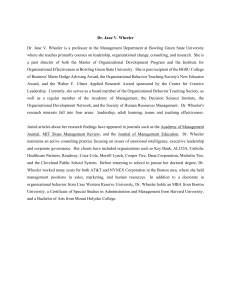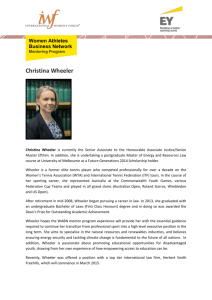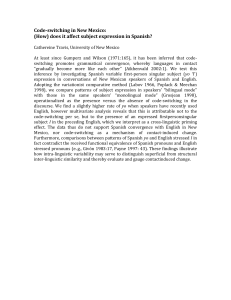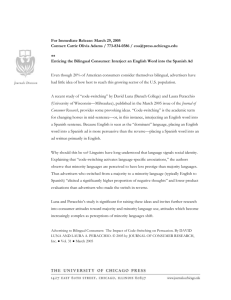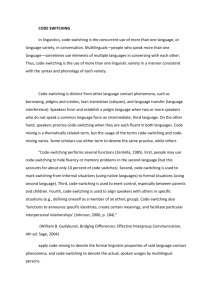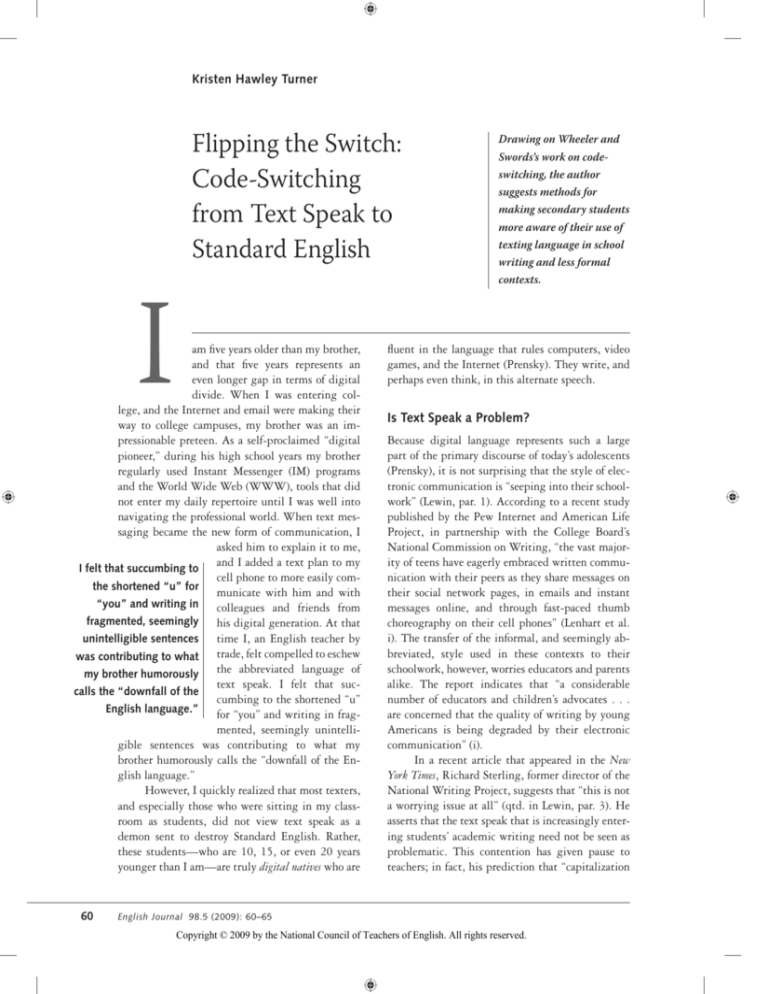
Kristen Hawley Turner
Flipping the Switch:
Code-Switching
from Text Speak to
Standard English
I
am five years older than my brother,
and that five years represents an
even longer gap in terms of digital
divide. When I was entering college, and the Internet and email were making their
way to college campuses, my brother was an impressionable preteen. As a self-proclaimed “digital
pioneer,” during his high school years my brother
regularly used Instant Messenger (IM) programs
and the World Wide Web (WWW), tools that did
not enter my daily repertoire until I was well into
navigating the professional world. When text messaging became the new form of communication, I
asked him to explain it to me,
and I added a text plan to my
I felt that succumbing to
cell phone to more easily comthe shortened “u” for
municate with him and with
“you” and writing in
colleagues and friends from
fragmented, seemingly
his digital generation. At that
time I, an English teacher by
unintelligible sentences
trade, felt compelled to eschew
was contributing to what
the abbreviated language of
my brother humorously
text speak. I felt that succalls the “downfall of the
cumbing to the shortened “u”
English language.”
for “you” and writing in fragmented, seemingly unintelligible sentences was contributing to what my
brother humorously calls the “downfall of the English language.”
However, I quickly realized that most texters,
and especially those who were sitting in my classroom as students, did not view text speak as a
demon sent to destroy Standard English. Rather,
these students—who are 10, 15, or even 20 years
younger than I am—are truly digital natives who are
60
Drawing on Wheeler and
Swords’s work on codeswitching, the author
suggests methods for
making secondary students
more aware of their use of
texting language in school
writing and less formal
contexts.
fluent in the language that rules computers, video
games, and the Internet (Prensky). They write, and
perhaps even think, in this alternate speech.
Is Text Speak a Problem?
Because digital language represents such a large
part of the primary discourse of today’s adolescents
(Prensky), it is not surprising that the style of electronic communication is “seeping into their schoolwork” (Lewin, par. 1). According to a recent study
published by the Pew Internet and American Life
Project, in partnership with the College Board’s
National Commission on Writing, “the vast majority of teens have eagerly embraced written communication with their peers as they share messages on
their social network pages, in emails and instant
messages online, and through fast-paced thumb
choreography on their cell phones” (Lenhart et al.
i). The transfer of the informal, and seemingly abbreviated, style used in these contexts to their
schoolwork, however, worries educators and parents
alike. The report indicates that “a considerable
number of educators and children’s advocates . . .
are concerned that the quality of writing by young
Americans is being degraded by their electronic
communication” (i).
In a recent article that appeared in the New
York Times, Richard Sterling, former director of the
National Writing Project, suggests that “this is not
a worrying issue at all” (qtd. in Lewin, par. 3). He
asserts that the text speak that is increasingly entering students’ academic writing need not be seen as
problematic. This contention has given pause to
teachers; in fact, his prediction that “capitalization
English Journal 98.5 (2009): 60–65
Copyright © 2009 by the National Council of Teachers of English. All rights reserved.
Kristen Hawley Turner
will disappear” (Lewin, par. 5) sparked a passionate
discussion among teacher consultants affiliated with
the National Writing Project site at Rutgers University. From the comment of one teacher who felt
“somewhat rattled” to the response from another,
who wrote her message with playful use of capital
letters (NWP Consultants), it is clear that teachers,
and particularly teachers of writing, are reacting to
the invasion of e-language into academic work.
Though Sterling’s unconventional remarks
certainly prompt debate, perhaps it is best to take
his comments in light of a wider issue. What happens when students bring informal language into
the classroom? Is text speak truly a problem, or is
its occurrence, as Sterling suggests, an opportunity
to teach students about the nature of language?
Researchers Rebecca S. Wheeler and Rachael
Swords contend that “we make a lot of assumptions
about the nature of language. . . . We assume that
Standard English is Right with a capital R, and
that anything else is improper, bad, incorrect, and
fractured” (5). Their book Code-Switching: Teaching
Standard English in Urban Classrooms outlines a plan
that builds on students’ existing knowledge by
contrasting their home language, or the language
they use unconsciously, with the Standard English
that is appropriate in school. Their argument centers on the idea that a student’s primary discourse
might be different from academic language; however, this difference does not make the student’s
language deficient. The authors suggest that teaching students to navigate between home and school
discourses, a task they call code-switching, privileges both languages.
Authors such as Wheeler and Swords have
helped me to think about the nature of language,
and each semester students in my English education courses consider, challenge, and debate traditional notions of acceptable language use. Our
discussions about primary and secondary discourses
often lead us to the somewhat ubiquitous text speak
in the lives of adolescents today. Instant messaging
programs, cell phone text messaging, and social
networking sites such as MySpace and Facebook
provide venues for communication that have become commonplace. As the Pew study documents,
students are using these technologies, and they are
becoming, or perhaps have already become, fluent
in the language associated with them. As digital
natives who have had access to computer technology all of their lives, they often demonstrate in
these arenas proficiencies that the adults in their
lives lack. Perhaps teachers and parents should not
look at this language as deficient; rather, we should
embrace students’ existing knowledge, as Wheeler
and Swords suggest, and teach them to negotiate
the technology-driven discourse within the confines
of school language. Using text speak as an example
of code-switching may acknowledge the legitimacy
of the language while bringing its use to the conscious level, where students can choose to use it or
not, depending on the context.
A “Flip the Switch” Classroom Activity
Wheeler and Swords suggest that contrastive analysis
will “help students uncover the systematic and detailed contrasts between the grammar of their home
language and the grammar of the school dialect as a
tool for learning [Standard English] more effectively” (27). The first step in this process allows
students to distinguish between informal and formal
patterns of language. Wheeler and Swords discuss
several activities that might introduce students to
the concept of formality and that will eventually
lead students to conscious code-switching. Inspired
by their work, my graduate students and I have
adapted their activities into
Is text speak truly a
a Flip the Switch (Wheeler
problem, or is its
and Swords 58) lesson that
serves to introduce the
occurrence, as Sterling
study of language by asksuggests, an opportunity
ing students to consider
to teach students about
their language use and to
the nature of language?
identify the differences between informal and formal
English. Though Wheeler and Swords focus such
lessons on culturally defined instances in which students demonstrate language patterns that confuse
or conflate informal and formal English, we have
expanded successfully this idea to the social adaptation of language into text speak.
To begin the Flip the Switch lesson, teachers
ask students to identify settings in which they communicate (e.g., school, church, playground) or individuals with whom they converse (e.g., parents,
friends, teachers). After the class has created a comprehensive list of these settings, the teacher, with
English Journal
61
Flipping the Switch: Code-Switching from Text Speak to Standard English
student input, selects four distinct communication
situations. The four categories might include classroom with teacher, MySpace with friend, lunchroom with friend, at home with parent.
Beginning with the first category, the class
translates a teacher-created sentence into each of the
four settings. For example, the teacher might offer
the following: “Hello. How is your day?”
Students identify which, if any, of the categories best fits this utterance. In this case, they might
list it under “classroom with teacher.” Then the
class translates it into the other situations. For instance, the same utterance in the lunchroom might
become, “Yo, what’s up?” At home students might
say to a parent, “Hi, Mom, how’s your day going?”
Inevitably, when students translate the sentence for
a digital communication, they will use text speak,
such as, “Hey . . . how r u?”
Once the translations have been written for
students to see, the teacher can guide a discussion
about the similarities and differences among them.
Students might note the more formal tone taken in
the classroom and the informal tone used among
friends. They might argue that they would use the
same language with their parents as with their
friends, and this debate will open other points of
discussion about contextual use of language.
After the whole-class discussion, the teacher
divides students into groups of three to four to conduct the activity again. Each group creates one utterance that might be used in
one of the social situations and
This type of activity
then translates it to the other
introduces the idea to
three settings. They can share
students that language
these sentences with the entire
varies by context, and it
class by writing them on the
will help them to see that
board under the appropriate
categories for the rest of the
what is appropriate in
class to see.
one setting may not be
A final step to the activappropriate in another.
ity is to have individual students write a sentence in the
appropriate language of one of the categories. As
individuals read their sentences aloud, the teacher
calls on the rest of the class to “flip the switch” to
the other categories. The teacher should increase
the pace of calling for students to “flip the switch”
as the activity continues, helping them to quickly,
yet consciously, code-switch.
62
May 2009
Blurring the Lines: Contexts
of Language Use
Typically, both in the graduate classes where I conduct the activity as an example and in the adolescent classrooms where my students experiment
with the activity, students are engaged and interested in seeing how their language changes from
one situation to another. As students reflect in their
notebooks on what it means to “flip the switch,”
they begin to develop a conscious awareness of the
language they use.
This type of activity introduces the idea to
students that language varies by context, and it
will help them to see that what is appropriate in
one setting may not be appropriate in another. In
technology-driven classrooms, however, this line
can become blurred. In an online discussion forum,
high school English teacher Valerie Mattessich
wrote the following post:
I am starting reading-response blogs with my students and am torn between allowing them to use
text-speak on their blogs, which will maximize
authenticity, and requiring proper capitalization
and punctuation, which will make me feel better
as an English teacher but may ruin the whole point
of blogging for them. Thoughts anyone?
The dilemma inherent in her post captures the feelings of many English teachers who understand that
the language that students use in digital settings is
different from that required in school. The pull between authentic writing and standard conventions
is strong, and the conflict may best be explored by
engaging the students themselves in a discussion
about the nature of their writing.
For example, by setting up an online writing
task where students are free to choose the code in
which they express their thoughts, teachers can collect valuable data about students’ choices. As a high
school teacher, I regularly engaged students in online discussion forums, and one of our first activities
post-writing was to examine the language used in
the forum. We discussed the online atmosphere as
an extension of the classroom, and I pointed to examples of students who chose conventions of text
speak and those who chose to write solely in Standard English. We discussed how writing in each
form might be perceived by readers and debated the
acceptable use of text speak in this context. By in-
Kristen Hawley Turner
viting students to look critically at their writing, I
brought the issues of vernacular and standard correctness to the forefront of their thinking, and in the
process, I negotiated the appropriate code for their
online work. Often students agreed that this online
writing should adhere to standard form because of
its connection to school. Interestingly, after making
this decision students themselves became the police
of their writing. Comments such as “Can we please
capitalize I?” or “Clean up your grammar” were not
uncommon in the posts of my sophomores. Without
my involvement, students navigated the language
and negotiated the code.
Though students often determined that Standard English should be the goal in their online discussion, students who regularly write in online
spaces for pleasure may make the argument that
text speak is equally appropriate in an online setting, regardless of the school-based context. Allowing the class to make the decision that text speak is
permissible in online contexts related to class work
may be somewhat worrisome for a teacher who developed an understanding of computer technology
later in life, one who is what Marc Prensky would
call a digital immigrant. However, doing so will
privilege the students’ language, giving it a space
within the school curriculum. In turn, the online
writing will be more authentic. Similarly, teachers
may allow students to use conventions of text speak
in their journals, brainstorming, or handwritten
rough drafts. The purpose of these tasks is for students to translate thought into writing. Doing so in
the code that comes most naturally to them may aid
their thinking and ultimately support their writing. Accepting text speak as viable for these types
of assignments provides another context in the
classroom for students to engage using their primary discourse.
The Goal: Language Awareness
Issues of correctness cannot be ignored, and students must be expected to polish drafts of their
writing using conventions of Standard English. In
their discussion of African American Vernacular,
Wheeler and Swords present the “Code-Switching
Shopping List” that asks students to examine their
writing by searching for the top ten “informal English patterns” and to “code-switch to formal En-
glish” (60). Similar to a traditional writing checklist
used for purposes of editing, students account for
the errors of Standard English and keep records of
their work. Adapting this activity for text speak requires that teachers engage their students in discussion of the conventions of digital writing. These
conventions may include abbreviations, phonetic
spellings, and nonstandard
Issues of correctness
capitalization and punctuacannot be ignored, and
tion, to name a few. Working together, students and
students must be
teachers can create a writexpected to polish drafts
ing checklist that focuses
of their writing using
solely on text speak, and
conventions of Standard
students can work individEnglish.
ually or in writing groups
to edit papers. (See Figure 1
for a sample checklist.) If students have been asked
to consider language throughout the year and have
practiced translating from text speak to Standard
English, they should be able to easily find these
“miscues” (Goodman, qtd. in Jacobs 209) that have
entered their formal writing.
The goal of these activities is to “develop
metacognitive awareness of how [students] switch
language and literacy practices according to context” (Jacobs 208). However, authors Teresa M.
Redd and Karen Schuster Webb point out that critics of code-switching practices argue that students
are asked only to translate from their primary discourse into the discourse of school and not the other
way around. In other words, code-switching is typically “one way,” and informal language is still seen
as a “deficiency” (86). To truly privilege the language of digital natives, teachers might ask for reverse translation. In other words, students can
rewrite plays or other pieces of literature using text
speak. The process of translating Shakespeare, for
example, into an IM conversation would make students think critically about language, even as it
would allow them to access traditionally difficult
texts using their primary discourse of text speak.
Their writing would aid in comprehension, and
their language may highlight the lasting relevance
of Shakespeare’s themes.
Parents and teachers may still question the
suitability of text speak in academic settings. Many
may argue that aside from its use as authentic dialogue and as a type of shorthand note taking, its
English Journal
63
Flipping the Switch: Code-Switching from Text Speak to Standard English
FIGURE 1. Text Speak Chart
Read your draft closely, looking for any convention of text speak. If you find one of our top five, place a check in the
box below and translate the text speak into Standard English in your writing. (You should add additional conventions
you find to our list.) Your goal by the end of the year is to have a draft that is free of text speak!
TEXT S PE AK CONVE NTI ONS
A S S I G N ME N T
1
A S S I G N ME N T
2
A S S I G N ME N T
3
A SSIG N MEN T
4
1. Using lowercase i
2. Using phonetic or shortened
spellings (e.g., u, cuz, r)
3. Omission of end punctuation
4. Omission of capital letters
(e.g., Beginning of sentence,
Proper Name)
5. Omission of apostrophes in
contractions (e.g., cant, isnt)
6.
7.
Note: This chart is based on the Shopping List activity designed by Wheeler and Swords. The categories above are based on anecdotal evidence from practicing high school and middle school teachers who suggest that students are using these conventions in
their formal writing. The categories may change depending on the conventions of text speak used by the majority of the students in
the class.
appropriateness in school is limited. However, as I
personally learned when many of my friends and
colleagues commented on my refusal to adapt my
digital language as I navigated
the new (to me) communicaIf teachers and parents
tion tools of texting and IM,
can acknowledge that
Standard English is not always
text speak is indeed
the acceptable language in the
appropriate in the digital
digital world. In fact, using
world that students
“correct” grammar, spelling,
navigate daily, then
and punctuation set me apart
from the community in an unperhaps we can see its
comfortable way. Text speak
use in school as a
allows me to enter this venue
difference, rather
and to assimilate effectively. If
than a deficit.
teachers and parents can acknowledge that text speak is
indeed appropriate in the digital world that students navigate daily, then perhaps we can see its use
in school as a difference, rather than a deficit, and
teach students how to code-switch from this language that has become part of their primary discourse into the more formal language of school and
the larger society.
64
May 2009
As I was composing the final lines of this article, an IM bubble popped up on my computer
screen.
poke
said my brother, who lives 3,000 miles away from
me. After exchanging sibling pleasantries, I told
him,
funny you poked me
i’m working on an article that mentions you
Our conversation continued.
My brother: do i do something cool in said
article
like breathe fire or shoot lasers from my eyes?
Me: hmmm . . . might be able to work that in
is texting cool?
My brother: cool?
i don’t really consider it cool or uncool
never really thought about it in the cool
context
Kristen Hawley Turner
Me: you are the middle generation between
Works Cited
digital natives and digital immigrants
Jacobs, Gloria E. “We Learn What We Do: Developing a
Repertoire of Writing Practices in an Instant Messaging World.” Journal of Adolescent and Adult Literacy
52.3 (2008): 203–11.
Lenhart, Amanda, Sousan Arafeh, Aaron Smith, and Alexandra R. Macgill. Writing, Technology and Teens. Pew
Internet and American Life Project. 24 Apr. 2008.
11 Sept. 2008 <http://www.pewinternet.org/PPF/
r/247/report_display.asp>.
Lewin, Tamar. “Informal Style of Text Messages Is Showing
Up in Schoolwork, Study Finds.” New York Times 25
Apr. 2008. 3 May 2008 <http://www.nytimes
.com/2008/04/25/education/25writing.html?ref=
education>.
Mattessich, Valerie. “Text Speak.” Online posting. 23 Nov.
2008. NWP@Rutgers Discussion Group. 23 Nov.
2008 <http://groups.yahoo.com/group/nwp_rutgers/
message/2229>.
NWP Consultants. “Former NWP Director Richard Sterling quoted in NYTimes.” Online posting. 3 May
2008. NWP@Rutgers Discussion Group. 3 May
2008 <http://groups.yahoo.com/group/nwp_rutgers/
message/2006>.
Prensky, Marc. “Digital Natives, Digital Immigrants.” On
the Horizon 9.5 (2001): 1–6. 11 Sept. 2008 <http://
www.marcprensky.com/writing/>.
Redd, Teresa M., and Karen Schuster Webb. A Teacher’s
Introduction to African American English: What a Writing Teacher Should Know. Urbana: NCTE, 2005.
Wheeler, Rebecca S., and Rachael Swords. Code-Switching:
Teaching Standard English in Urban Classrooms. Urbana:
NCTE, 2006.
i am a digital immigrant
My brother: i’m a digital pioneer
mostly because the internet really kicked off
when i first legally became an adult
We continued our chat, determining that
while “digital dinosaur” sounded “fun,” both of us
had too much digital knowledge to fit that category. We signed off with promises to hitch our
wagons and continue in the pioneer generation.
As I looked back at our conversation, captured
conveniently on my computer screen, I noted the
lack of capitals and end punctuation, and I flipped
to this article, realizing that I myself have developed the ability to code-switch effortlessly between
the text speak I use online and the Standard English
I use in my academic life. Perhaps this digital immigrant can begin to identify with the digital natives who enter her classroom. And perhaps
privileging the language that represents their world
outside of school will make teachers like me pioneers in the next generation.
Kristen Hawley Turner is assistant professor of English education at Fordham University and a consultant for the National
Writing Project. A former high school English and social studies teacher, she works with inservice and preservice teachers to
improve literacy practices across content areas. She may be reached at krturner@fordham.edu.
Search for New Editor of English Leadership Quarterly
NCTE is seeking a new editor of English Leadership Quarterly. In April 2011, the term of the present editors
(Lisa Scherff and Susan L. Groenke) will end. Interested persons should send a letter of application to be
received no later than August 14, 2009. Letters should include the applicant’s vision for the journal and
be accompanied by the applicant’s vita and one sample of published writing. If applicable, please send at
least one letter of general support from appropriate administrators at the applicant’s institution. Do not
send books, monographs, or other materials that cannot be easily copied for the Search Committee. Classroom teachers are both eligible and encouraged to apply. The applicant appointed by the CEL Executive
Committee will effect a transition, preparing for his or her first issue in August 2011. The initial appointment is for four years, renewable for three years. Applications should be addressed to Kurt Austin, English
Leadership Quarterly Search Committee, NCTE, 1111 W. Kenyon Road, Urbana, IL 61801-1096. Questions
regarding any aspect of the editorship should be directed to Kurt Austin, Publications Division Director:
kaustin@ncte.org; (800) 369-6283, extension 3619.
English Journal
65


